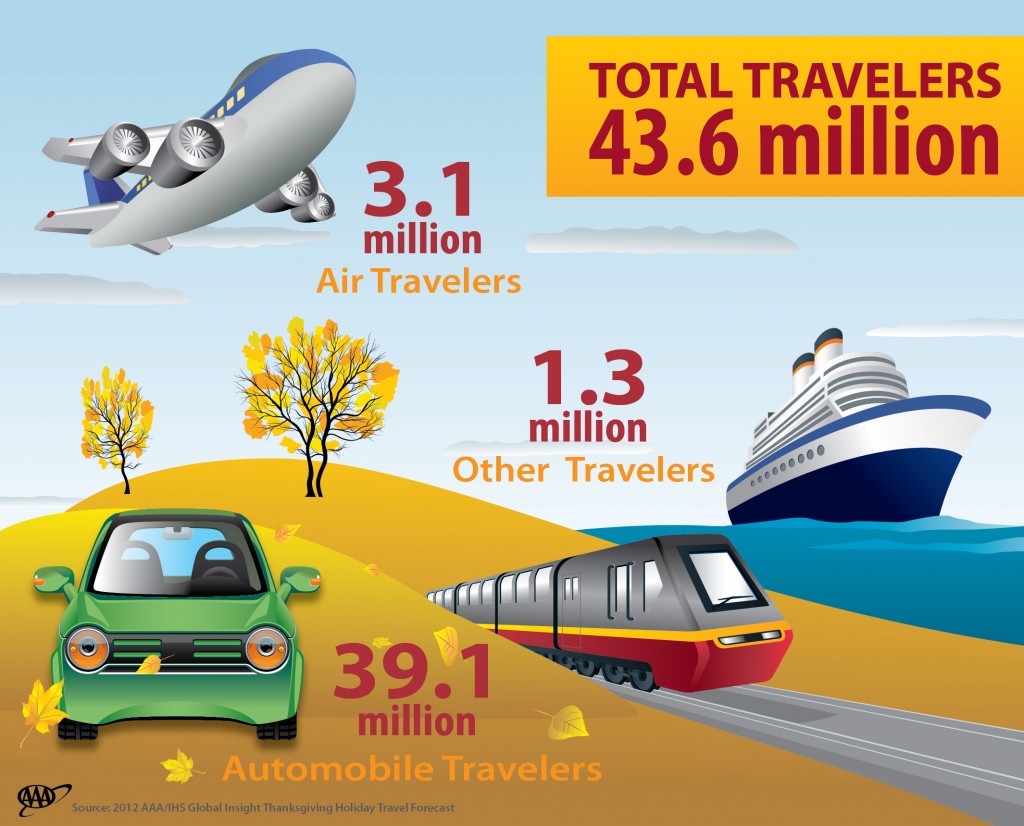By DiscoverTheOdds.com
Updated December 14, 2013
The Thanksgiving holiday marks one of the busiest holiday travel periods of the year. Many US residents will travel great distances to spend time with family and friends on or before Thanksgiving Day. Though some US travelers will travel by airplane or other modes of transportation, most will travel by automobile. Let’s take a look at the travel forecasts for this year, the odds of being in a fatal car accident this Thanksgiving and what you can do to reduce those odds.
Thanksgiving Holiday Travel
According to the AAA /IHS Global Insight 2012 Thanksgiving Holiday Travel Forecast, 43.6 million US residents will engage in long-distance travel (round-trip distances of 50 miles or more) this Thanksgiving. Of that number, an estimated 39.1 million will travel by automobile, 3.1 million will fly to their respective destinations, and 1.3 million will utilize other modes of transportation. Automobile travel will account for 90% of all 2012 Thanksgiving travel.
The complete AAA /IHS Global Insight 2012 Thanksgiving Holiday Travel Forecast can be found at NewsRoom.AAA.com.
What Are The Odds of Being Killed In A Car Accident This Thanksgiving?
The National Safety Council (NSC) releases an annual Thanksgiving Holiday Period Traffic Fatality Estimate based on total November deaths and data from Fatality Analysis Reporting System (FARS). For the 2012 Thanksgiving holiday period spanning from 6:00 p.m. Wednesday, November 21, to 11:59 p.m. Sunday, November 25, the NSC report estimates that there will be 451 traffic fatalities from crashes. Based on this NSC estimate:
The odds of being killed in a car accident during the Thanksgiving Holiday are 1 in 697,917.
In addition to traffic fatalities, nonfatal injuries are also addressed in the NSC report. The NSC estimates that 48,300 nonfatal disabling injuries will result from crashes during the 2012 Thanksgiving Holiday period. Based on this NSC estimate:
The odds of suffering a nonfatal disabling injury as a result of a car crash during the 2012 Thanksgiving Holiday are 1 in 6,517.
However, the NSC report also puts its estimate into perspective by comparing the Thanksgiving holiday weekend to the data for comparable weekends in November (from 6:00 p.m. Wednesday to 11:59 p.m. Sunday of the weeks immediately before and after the Thanksgiving weekend) for 2005 to 2010. For those six years, the report states, the average number of traffic deaths over the Thanksgiving holiday weekend was just “9.8% higher than the average number of traffic deaths during the comparison periods (512 vs. 466 deaths). The difference between these two means is not statistically significant.”
The report also cites an earlier study by Arnold and Cerrelli (1987) that analyzed FARS data from 1975-1985. Examining average daily fatalities for each day of the week in each month, Arnold and Cerrelli “found that fatalities rose 42% on the Wednesday before Thanksgiving and were 19% higher than normal on Thanksgiving Day. Fatalities were normal on the Friday, Saturday, and Sunday following the holiday.”
Reducing The Odds
While you don’t have control of the increased traffic volume the holidays bring, there are a few things you can do to reduce your odds of being involved in a fatal car accident:
- Don’t drive while under the influence of alcohol. Alcohol impairment is a factor in many traffic fatalities and the problem is compounded during the holidays when people engage in increased alcohol consumption.
- Try to limit nighttime driving. More crashes occur at night than during the daytime hours.
- Wear your glasses or contacts lenses if you need them. Though it may be ideal to drive during the day, you may still end up driving after dark; limited lightning exacerbates vision problems and increases the risk of collision involvement, so wearing corrective lenses is especially important at night.
- Wear a seat belt. Wearing a seat belt can reduce your risk of traffic-related injury or fatality by 50%, so remember to buckle up.





